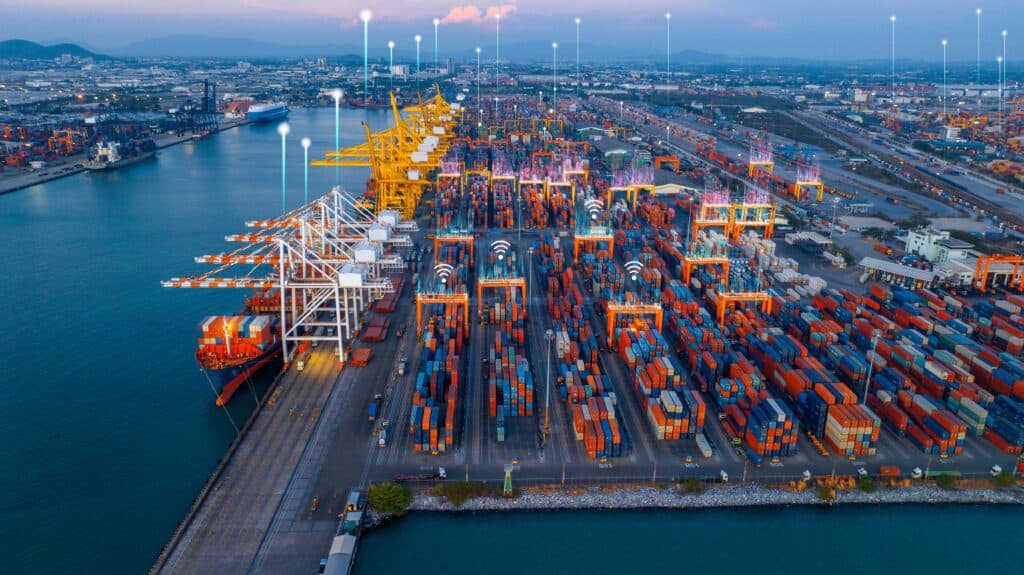Ushering in a new era of efficiency and innovation
This is the third blog in our continuing series on private mobile networks (PMNs). Read part one for more on what the technology is and how it works, and part two to learn how private mobile networks can be applied by industries across Australia.
Ports all over the world are busier than ever, facing intense demands in a global economy that leans heavily on shipping. Container volumes are hitting record highs, with 15.9 million twenty-foot equivalent unit (TEU) shipped globally in May 2024 alone. Australia’s ports are no different. The amount of container cargo shipped through them has grown by 30 percent over the past decade, while the number of vessels visiting our ports has climbed by 20 percent over that same period.
Despite their importance to the economy, many ports are grappling with outdated infrastructure, rising congestion and limited opportunities for physical expansion. In urban locations especially, there often isn’t any room to add more berths. All of this has amplified the need for ports to adopt innovative, digital-first solutions. With a private mobile network, for example, ports can maximise usage of their existing infrastructure, streamline operations and ease congestion. Internet of Things (IoT) sensors, automated vehicles and other technologies can bring significant benefits, allowing ports to boost capacity and reduce their environmental impacts — so they can stay competitive in an increasingly complex global supply chain.
The power of a private mobile network
PMNs are emerging as the optimal solution for addressing the challenges facing ports today. Using 4G and 5G technology, they offer secure, high-performance wireless connectivity tailored to the specific needs of port environments. The dedicated bandwidth of a PMN ensures reliable communications across vast, complex areas, helping ports optimise operations, reduce downtime and improve safety. This technology empowers ports to modernise their infrastructure and boost cargo-handling capacity without the need for physical expansion. As a result, they can better meet the increasing demands of global trade, enhance productivity, and improve the predictability and reliability of terminal performance – all of which are critical to the shipping industry.
Operational efficiency comes first
By providing blanket network coverage and capacity across an entire port, a PMN can enhance operations by making it possible for dock workers and security personnel to view cargo manifests, access work instructions, schedule jobs, track containers and more, no matter where they go. Even something as simple as having reliable access to voice and video communications makes it easier to coordinate tasks or call for help during emergencies.
Beyond that, a PMN can also significantly boost many of the key performance indicators ports use to measure operational efficiency, including:
- Truck turnaround times: Automated gate operations with digital check-in systems play a vital role in reducing how long trucks must wait to enter or exit port boundaries. By using wireless cameras and scanners, ports can detect licence plates and electronic IDs, speeding up driver verification. At the same time, using automated guided vehicles (AGVs) for the horizontal transport of goods (i.e., moving cargo between trucks and ships) can relieve congestion and greatly reduce the time trucks spend waiting to load or unload containers. Enabled by continuous wireless connectivity, real-time data sent by each AGV can be used to orchestrate and automate routing and task allocation, optimising AGV traffic flow and ensuring they can operate 24/7. A PMN also ensures fast-moving vehicles maintain connectivity throughout the port area by facilitating seamless handovers from one radio cell to another (resolving an issue with Wi-Fi technology where there can be a drop in connectivity from one cell to the next). And with the size of AGV fleets growing by more than 25% year-on-year, PMNs also provide the scalable capacity needed to eventually connect hundreds of AGVs.
- Container movements per hour: Gantry cranes, quay cranes and straddle carriers do much of the heavy lifting at a port by loading, unloading, moving and stacking containers. While most of these functions can be automated, some tasks still require manual operation and supervision. But crane operators can spend as much as 25% of each day moving around the port to get from one crane to another, or waiting in their current spot for the next queued job because the time for switching between cranes is just too high. Remote controls allows a single operator in a central location to quickly switch between different cranes or adopt a team-based approach to eliminate downtime completely. A PMN is key to being able to remotely operate this equipment, providing high-throughput wireless connections to transmit multiple video streams as well as the low-latency connectivity needed to carry critical, time-sensitive control signalling.
- Berth availability and vessel dwell times: Ports run offline and online simulations to better understand how quickly vessels can enter and leave the harbour under different conditions. Those simulations need a lot of data to be effective. With a PMN, it’s possible to deploy wireless sensors on buoys to collect real-time data on weather and metocean conditions such as waves and tides within shipping channels, resulting in more accurate simulations that will reduce the queues of ships waiting at anchor. Vessel manoeuvring and mooring within the harbour, meanwhile, depends on essential services provided by tugboats, pilot vessels and patrol boats. A PMN can deliver secure, high-speed near-shore communications for these vessels, improving coordination and navigation for safer and more efficient arrivals and departures.
Safety and security are vital
To improve physical safety and security, workers can be equipped with wearable sensors that track their precise location as well as their proximity to hazards such as heavy machinery or moving vehicles. Dangerous areas can be geofenced, sending automatic alerts if somebody inadvertently enters. Video analytics of live streams from wireless cameras and drones can be used for real-time asset tracking and surveillance, improving situational awareness of operations and security teams. And with around 50% of port safety incidents arising from slipping/tripping, vehicle driving and manual handling activities, simply being able to do more tasks remotely or through automation also improves worker safety.
Physical security is just part of the equation. Cybersecurity is equally important. Australia’s critical infrastructure is under constant threat — and any downtime can have significant consequences on the economy. Protecting data from cyber-attacks requires robust information security and risk management strategies. Advanced security is built natively into a PMNs design, including SIM-based authentication and identity management to ensure only authorised handsets and devices can connect to the network. On-premises edge gateways make sure all user data stays on site, greatly reducing the risk of exposure or theft. Even if the public networks go down, a PMN can be isolated from them, continuing to support port operations with no interruption.
PMN in action: Port of Kokkola
PMNs aren’t just the future. The Port of Kokkola has been using private mobile networks (PMNs) for the past four years, significantly enhancing its efficiency and operational capabilities. As Finland’s largest dry bulk port, Kokkola relies on this dedicated, secure network to manage its vast cargo volumes and complex logistics processes. The PMN’s enhanced coverage and low latency have enabled the integration of connected IoT devices for monitoring water usage, energy meters, and septic tanks. Additionally, 32 cameras are used for site monitoring, while remote work and the control of assets and equipment are handled through dedicated applications, ensuring smooth and secure operations across the port’s infrastructure.
A key advantage of Kokkola’s private network is the ease of access to critical data, allowing the port to offer just-in-time arrival slots for ships. This capability enables vessels to regulate their speed enroute, reducing fuel consumption and operational costs by avoiding port delays. With optimised arrival times, the port not only increases efficiency but also promotes environmental sustainability through reduced emissions.
The long-term use of PMNs at the Port of Kokkola has also paved the way for future scalability and the integration of advanced technologies. As the port continues to grow, its network can easily support additional IoT devices, automation systems, and AI-driven analytics for predictive maintenance. This flexibility ensures the port is well-positioned to meet evolving industry demands.
Augment your port’s operations with BAI
Private mobile networks aren’t new to Australia’s ports either. Several mining ports in remote parts of the country have already integrated PMNs. But in the urban areas where most container terminals are located, the lack of spectrum availability for private enterprise use has been the primary roadblock to PMN adoption. However, as new spectrum will be released imminently, there will be more opportunities in more places to create safer, more efficient ports.
As Australian ports adopt these networks, BAI Communications is well-positioned to support this transition. With deep expertise in deploying and managing advanced communications infrastructure, backed by a strong understanding of local regulations, we can help ensure ports are able to effectively harness the benefits of PMNs to drive innovation and efficiency in their operations.
Contact us to learn how our team can help you put in a place a private mobile network tailored to your operations or download our brochure for more information on our connectivity solutions for ports.








